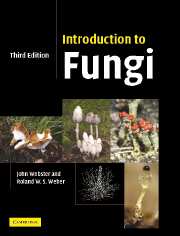Book contents
- Frontmatter
- Contents
- Preface to the first edition
- Preface to the second edition
- Preface to the third edition
- Acknowledgements
- 1 Introduction
- 2 Protozoa: Myxomycota (slime moulds)
- 3 Protozoa: Plasmodiophoromycota
- 4 Straminipila: minor fungal phyla
- 5 Straminipila: Oomycota
- 6 Chytridiomycota
- 7 Zygomycota
- 8 Ascomycota (ascomycetes)
- 9 Archiascomycetes
- 10 Hemiascomycetes
- 11 Plectomycetes
- 12 Hymenoascomycetes: Pyrenomycetes
- 13 Hymenoascomycetes: Erysiphales
- 14 Hymenoascomycetes: Pezizales (operculate discomycetes)
- 15 Hymenoascomycetes: Helotiales (inoperculate discomycetes)
- 16 Lichenized fungi (chiefly Hymenoascomycetes: Lecanorales)
- 17 Loculoascomycetes
- 18 Basidiomycota
- 19 Homobasidiomycetes
- 20 Homobasidiomycetes: gasteromycetes
- 21 Heterobasidiomycetes
- 22 Urediniomycetes: Uredinales (rust fungi)
- 23 Ustilaginomycetes: smut fungi and their allies
- 24 Basidiomycete yeasts
- 25 Anamorphic fungi (nematophagous and aquatic forms)
- References
- Index
- Plate section
6 - Chytridiomycota
- Frontmatter
- Contents
- Preface to the first edition
- Preface to the second edition
- Preface to the third edition
- Acknowledgements
- 1 Introduction
- 2 Protozoa: Myxomycota (slime moulds)
- 3 Protozoa: Plasmodiophoromycota
- 4 Straminipila: minor fungal phyla
- 5 Straminipila: Oomycota
- 6 Chytridiomycota
- 7 Zygomycota
- 8 Ascomycota (ascomycetes)
- 9 Archiascomycetes
- 10 Hemiascomycetes
- 11 Plectomycetes
- 12 Hymenoascomycetes: Pyrenomycetes
- 13 Hymenoascomycetes: Erysiphales
- 14 Hymenoascomycetes: Pezizales (operculate discomycetes)
- 15 Hymenoascomycetes: Helotiales (inoperculate discomycetes)
- 16 Lichenized fungi (chiefly Hymenoascomycetes: Lecanorales)
- 17 Loculoascomycetes
- 18 Basidiomycota
- 19 Homobasidiomycetes
- 20 Homobasidiomycetes: gasteromycetes
- 21 Heterobasidiomycetes
- 22 Urediniomycetes: Uredinales (rust fungi)
- 23 Ustilaginomycetes: smut fungi and their allies
- 24 Basidiomycete yeasts
- 25 Anamorphic fungi (nematophagous and aquatic forms)
- References
- Index
- Plate section
Summary
Introduction
The phylum Chytridiomycota comprises over 900 species in five orders (D. J. S. Barr, 2001; Kirk et al., 2001). Fungi included here are colloquially called ‘chytrids’. Most chytrids grow aerobically in soil, mud or water and reproduce by zoospores with a single posterior flagellum of the whiplash type, although the zoospores of some members of the Neocallimastigales are multiflagellate. Some species inhabit estuaries and others the sea. Sparrow (1960) has given an extensive account of aquatic forms, Karling (1977) a compendium of illustrations, and Powell (1993) has provided examples of the importance of the group. Many members are saprotrophs, utilizing cellulose, chitin, keratin, etc., from decaying plant and animal debris in soil and mud, whilst species of Caulochytrium grow as mycoparasites on the mycelium and conidia of terrestrial fungi (Voos, 1969). Saprotrophs can be obtained in crude culture by floating baits such as cellophane, hair, shrimp exoskeleton, boiled grass leaves and pollen on the surface of water overlying samples of soil, mud or pieces of aquatic plant material (Sparrow, 1960; Stevens, 1974; Willoughby, 2001). From such crude material, pure cultures may be prepared by streaking or pipetting zoospores onto agar containing suitable nutrients and antibiotics to limit contamination from bacteria. The growth and appearance of chytrids in pure culture is variable and often differs significantly from their natural habit. This has led to problems in classification systems based on thallus morphology (Barr, 1990, 2001). The availability of cultures has, however, facilitated studies on chytrid nutrition and physiology (Gleason, 1976).
- Type
- Chapter
- Information
- Introduction to Fungi , pp. 127 - 164Publisher: Cambridge University PressPrint publication year: 2007
- 1
- Cited by



